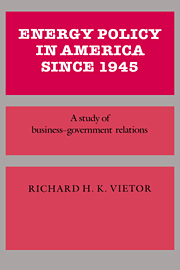Book contents
- Frontmatter
- Contents
- List of charts and figures
- List of tables
- Editors' preface
- Acknowledgments
- List of abbreviations
- 1 Introduction: The political economy of energy
- Part I The transition to peace and fluid fuels, 1945–1958
- 2 The foundations of postwar policy
- 3 “Stepping right out” with synthetic fuels
- 4 Regulating natural gas in the absence of economics
- 5 Oil imports: the failure of voluntarism
- Part II Managing surplus through the politics of stasis, 1959–1968
- Part III The second energy transition: adjustment to depletion, 1969–1980
- Index
4 - Regulating natural gas in the absence of economics
Published online by Cambridge University Press: 13 October 2009
- Frontmatter
- Contents
- List of charts and figures
- List of tables
- Editors' preface
- Acknowledgments
- List of abbreviations
- 1 Introduction: The political economy of energy
- Part I The transition to peace and fluid fuels, 1945–1958
- 2 The foundations of postwar policy
- 3 “Stepping right out” with synthetic fuels
- 4 Regulating natural gas in the absence of economics
- 5 Oil imports: the failure of voluntarism
- Part II Managing surplus through the politics of stasis, 1959–1968
- Part III The second energy transition: adjustment to depletion, 1969–1980
- Index
Summary
In the forties and fifties, a relatively new source of energy spread rapidly to all regions of the United States. This was natural gas. Earlier, it has been used locally, in the Southwest; now it became the basis of a national industry. The public interest seemed to require that this emerging industry be regulated, but regulated how? The attempt was fraught with complications. Among these were jurisdictional disputes between state and federal authorities, frictions among regions, clashes of ideology, issues of conservation and end-use, and the crucial question of whether wellhead prices would be determined by government or the market. Resolution of these problems proved to be intensely controversial, illogical, and eventually elusive. The result was a gas crisis more than two decades later.
Prior to World War II, natural gas was a by-product of the search for petroleum. Exploratory wells that yielded only gas were considered commercial failures. To the extent that gas was often found with petroleum, it was either reinjected to enhance petroleum recovery, used as a power source in the oil fields, or sold to produce heat and light in adjacent communities. (The gas used for lighting in eastern cities was manufactured by a simple but inefficient process of cooking coal.) Otherwise, natural gas was flared (burned off) as an effluent. As late as 1944, less than half of gross gas production was marketed to transmission lines.
- Type
- Chapter
- Information
- Energy Policy in America since 1945A Study of Business-Government Relations, pp. 64 - 90Publisher: Cambridge University PressPrint publication year: 1984

